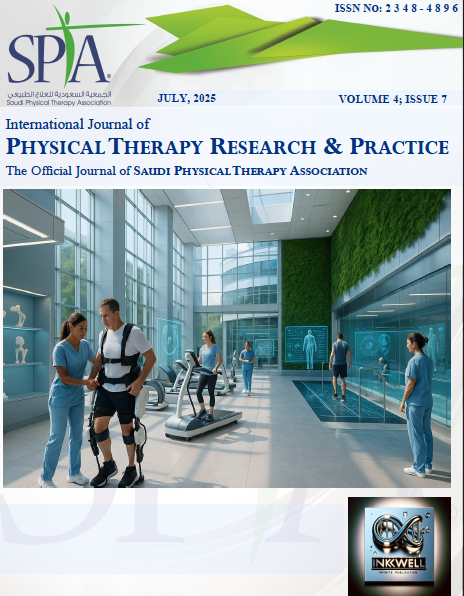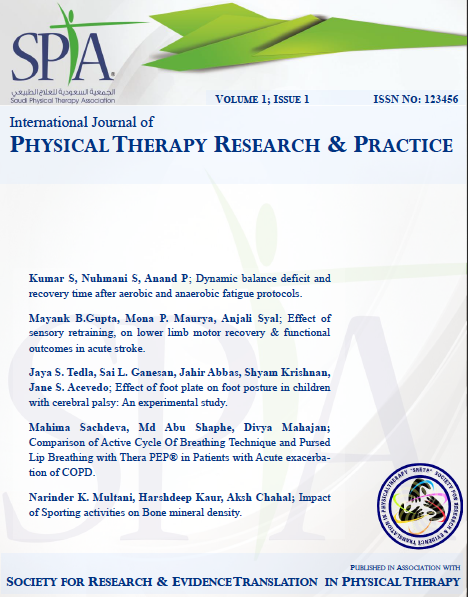Association Between Patient Lifting Systems and Musculoskeletal Disorders Among Nurses in Saudi Arabia: A Cross-Sectional Study
DOI:
https://doi.org/10.62464/ijoprp.v4i7.110Keywords:
Nurses, Musculoskeletal Disorders (MSDs), Patient Lifting Systems, Manual Handling, Saudi Arabia, PainAbstract
Background: This cross-sectional study investigated the association between the use of patient lifting systems and the prevalence of musculoskeletal disorders (MSDs) among nurses in Saudi Arabia. It also examined the influence of lifting frequency, ergonomic knowledge, and sociodemographic factors. Methods: An electronic survey was distributed to 51 nurses between January and June 2023. The survey collected data on sociodemographic, patient lifting system usage frequency, and MSDs using the Nordic Musculoskeletal Questionnaire (NMQ) and the Visual Analogue Scale (VAS). Chi-square tests assessed associations, and logistic regression identified significant MSD risk factors. Results: Among the 51 nurses (mean age = 35.64 years), 35.3% used lifting systems sometimes, 37.3% rarely, and 15.7% never. A total of 25.5% reported insufficient ergonomic training. Frequent use of hoists was significantly associated with lower MSD prevalence (p < 0.001). Logistic regression showed that younger age (OR = 1.628, p = 0.020) and female gender were predictors of higher MSD risk. Lower back pain was the most reported issue (63%), but its severity was lower among nurses who regularly used lifting devices. Conclusion: Frequent use of patient lifting systems was associated with a lower prevalence and severity of MSDs, particularly lower back pain. However, inconsistent use and inadequate ergonomic training may limit their protective benefits. Healthcare facilities should prioritize training and encourage routine use of lifting systems to mitigate MSD risk among nursing staff.
References
Alruwaili, S. H., A. Thirunavukkarasu, R. M. Alanazi, et al., 2023. Prevalence, Patterns, and Associated Factors for Musculoskeletal Disorders Among the Healthcare Workers of Northern Saudi Arabia: A Multicenter Cross-Sectional Study. J Pain Res. 16 3735-3746. https://doi.org/10.2147/jpr.S415919
Carlson, E., 2008. Safe Patient Handling and Movement: A Guide for Nurses and Other Health Care Providers. Orthopaedic Nursing. 27 153. https://doi.org/10.1097/01.NOR.0000315634.76417.c4
Choi, S. D. and K. Brings, 2015. Work-related musculoskeletal risks associated with nurses and nursing assistants handling overweight and obese patients: A literature review. Work. 53 (2) 439-448. https://doi.org/10.3233/wor-152222
da Costa, B. R. and E. R. Vieira, 2010. Risk factors for work-related musculoskeletal disorders: A systematic review of recent longitudinal studies. Am J Ind Med. 53 (3) 285-323. https://doi.org/10.1002/ajim.20750
Dawson, A. P., S. N. McLennan, S. D. Schiller, et al., 2007. Interventions to prevent back pain and back injury in nurses: a systematic review. Occup Environ Med. 64 (10) 642-650. https://doi.org/10.1136/oem.2006.030643
Harcombe, H., D. McBride, S. Derrett, et al., 2009. Prevalence and impact of musculoskeletal disorders in New Zealand nurses, postal workers and office workers. Aust N Z J Public Health. 33 (5) 437-441. https://doi.org/10.1111/j.1753-6405.2009.00425.x
Hoy, D., L. March, P. Brooks, et al., 2014. The global burden of low back pain: estimates from the Global Burden of Disease 2010 study. Ann Rheum Dis. 73 (6) 968-974. https://doi.org/10.1136/annrheumdis-2013-204428
Kugler, H. L., N. F. Taylor and N. K. Brusco, 2024. Patient handling training interventions and musculoskeletal injuries in healthcare workers: Systematic review and meta-analysis. Heliyon. 10 (3) e24937. https://doi.org/10.1016/j.heliyon.2024.e24937
Lagerström, M., M. Wenemark, M. Hagberg, et al., 1995. Occupational and individual factors related to musculoskeletal symptoms in five body regions among Swedish nursing personnel. Int Arch Occup Environ Health. 68 (1) 27-35. https://doi.org/10.1007/bf01831630
Leijon, M., G. Hensing and K. Alexanderson, 2004. Sickness absence due to musculoskeletal diagnoses: association with occupational gender segregation. Scand J Public Health. 32 (2) 94-101. https://doi.org/10.1080/14034940310006195
Luan, H. D., N. T. Hai, P. T. Xanh, et al., 2018. Musculoskeletal Disorders: Prevalence and Associated Factors among District Hospital Nurses in Haiphong, Vietnam. Biomed Res Int. 2018 3162564. https://doi.org/10.1155/2018/3162564
Nelson, A., J. Lloyd, N. Menzel, et al., 2003. Preventing Nursing Back Injuries: Redesigning Patient Handling Tasks. AAOHN journal : official journal of the American Association of Occupational Health Nurses. 51 126-134. https://doi.org/10.1177/216507990305100306
Shieh, S. H., F. C. Sung, C. H. Su, et al., 2016. Increased low back pain risk in nurses with high workload for patient care: A questionnaire survey. Taiwan J Obstet Gynecol. 55 (4) 525-529. https://doi.org/10.1016/j.tjog.2016.06.013
Sikiru, L. and S. Hanifa, 2010. Prevalence and risk factors of low back pain among nurses in a typical Nigerian hospital. Afr Health Sci. 10 (1) 26-30.
Smith, D. R. and P. A. Leggat, 2004. Musculoskeletal disorders among rural Australian nursing students. Aust J Rural Health. 12 (6) 241-245. https://doi.org/10.1111/j.1440-1854.2004.00620.x
Soylar, P. and A. Ozer, 2018. Evaluation of the prevalence of musculoskeletal disorders in nurses: A systematic review. Medicine Science. 7 1. https://doi.org/10.5455/medscience.2017.06.8747
Tinubu, B. M., C. E. Mbada, A. L. Oyeyemi, et al., 2010. Work-related musculoskeletal disorders among nurses in Ibadan, South-west Nigeria: a cross-sectional survey. BMC Musculoskelet Disord. 11 12. https://doi.org/10.1186/1471-2474-11-12
Trinkoff, A. M., R. Le, J. Geiger-Brown, et al., 2007. Work schedule, needle use, and needlestick injuries among registered nurses. Infect Control Hosp Epidemiol. 28 (2) 156-164. https://doi.org/10.1086/510785
Verbeek, J. H., K. P. Martimo, P. P. Kuijer, et al., 2012. Proper manual handling techniques to prevent low back pain, a Cochrane systematic review. Work. 41 Suppl 1 2299-2301. https://doi.org/10.3233/wor-2012-0455-2299

Downloads
Published
Issue
Section
License
Copyright (c) 2025 International Journal of Physical Therapy Research & Practice

This work is licensed under a Creative Commons Attribution-NonCommercial-NoDerivatives 4.0 International License.



